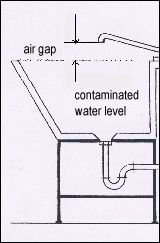| Cross contamination. Cross connections. Air gap |
 |
| Always maintain a proper gap between tip of faucet and top of laundry tub, see text. |
OTHER SOURCES OF WATER CONTAMINATION
- When watermains are being repaired or replaced. During construction water and soil may enter the watermain. After the work is completed and the pressure is back to normal open all faucets and taps to flush out any potential contaminants.
- Water contamination occurred in Minnesota in 1978 after a herbicide was back siphoned from a farmer's tank truck into a city's water system. The farmer filled his water tank from a hose at the city's water plant. The water pressure suddenly dropped and the pesticide in the truck was siphoned into the city's water system. Fortunately, no illness from the contamination occurred, but the city had to limit it's water use until the entire system could be flushed and refilled with clean water. Similar accidents can happen anytime anywhere. |
TIP
Whether you fill up the swimming pool, pond or truck (see Minnesota accident above) always keep the hose out of the water. If the hose is not submerged, there will be no water contamination when the water pressure drops unexpectedly. |
|
| Cross Connections - Water Contamination |
|
|
Cross contamination. Cross connections. Air gap
Water contamination through cross connections is something that can happen to any homeowner any time. There are situations in and around the home and even down the road or in your community that can contaminate the drinking water in your home.
- What is cross connections
- Where can it happen in and around the home
- Drop in water pressure - Places where cross connections can occur
- How to prevent cross connections
- Other sources of water contamination
WHAT IS CROSS CONNECTIONS?
Cross connections occurs when dirty used water is returned, through a faucet or tap, to the potable water supply lines in the house. This unwanted backflow happens when there is a significant drop in water pressure. If nothing is done to prevent it from happening your drinking water will get contaminated and could adversely affect your health.
CROSS CONNECTIONS CAN OCCUR
* When a garden hose connected to a pesticide/fertilizer sprayer or pressure washer.
* When a garden hose is left submersed when filling or topping up a pond or swimming pool.
* When there is an underground sprinkler (irrigation) system.
* When the watermain in the street is repaired or replaced.
* When a hose is attached to the laundry tub taps or where the tub is used for draining the washing machine.
If there would be a sudden drop in water pressure, pesticide/fertilizers, pool chemicals, soapy water and soil will contaminate your drinking water if there are, no anti-syphon taps, backflow preventive devices, etc., installed or hoses under pressure, left submerged.
|
If the laundry tub drain gets plugged, used water will fill the tub.
The drain for the washing machine should be installed higher
than the top of the tub to prevent water contamination.
|
|
DROP IN WATER PRESSURE COULD HAPPEN,
- During a large fire a significant amount of water is drawn from fire hydrants which could result in low water pressure in homes which are connected to the same watermain.
- When the watermain in your street is replaced or repaired. The water supply will be cut off completely and there will be no water pressure at all till the water is turned on again.
HOW TO PREVENT CROSS CONTAMINATION
- When filling or topping up the pond or swimming pool do not submerge the garden hose but have it positioned well above to water level.
- Install a backflow preventive system in the supply line feeding the underground sprinklers. This could be expensive as the devices should be installed by a professional and require an annual inspection.
- Install anti-syphon hose bibbs.
- Laundry tub. Maintain an air gap, see image to the left. Depending on where you live the required air gap is 1" to 2" (25 to 50 mm) or three times the diameter of the water supply line to the laundry tub.
- Laundry tub. If you have been using a faucet attachment (like a handheld sprayer to clean the dog) make sure to remove it after use.
- If the washing machine drain is discharged into the laundry tub make sure that tub drain is not clogged. The drain should be able to disperse all water without backing up.
FOR MORE INFORMATION SEE ALSO
Faucets - Hose bibb, spigot, sill cock
Laundry Tubs, Sinks and Taps
Lead in drinking water from faucets, solder and watermains
|
|
|
|
|
Back to Top |
|
|